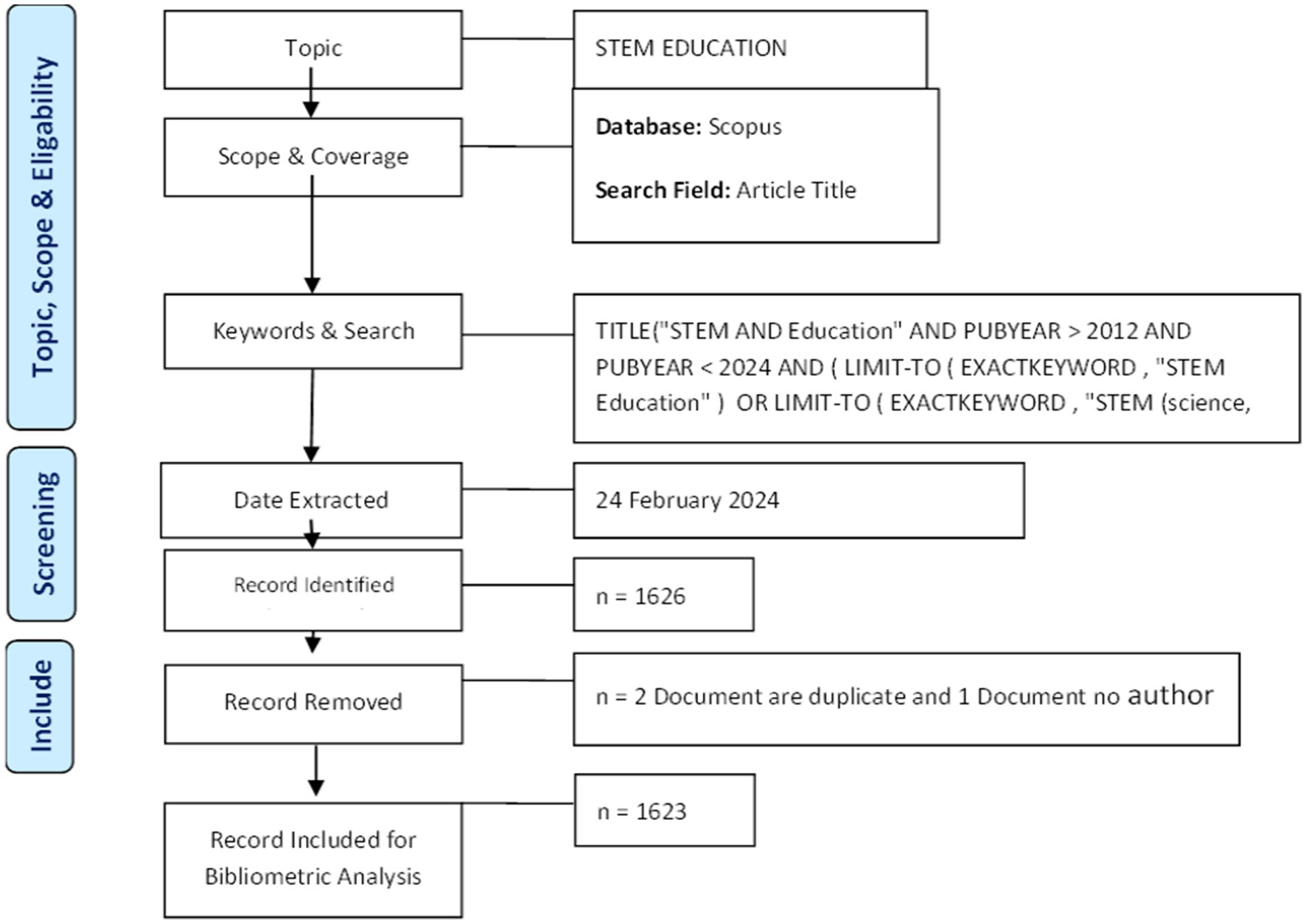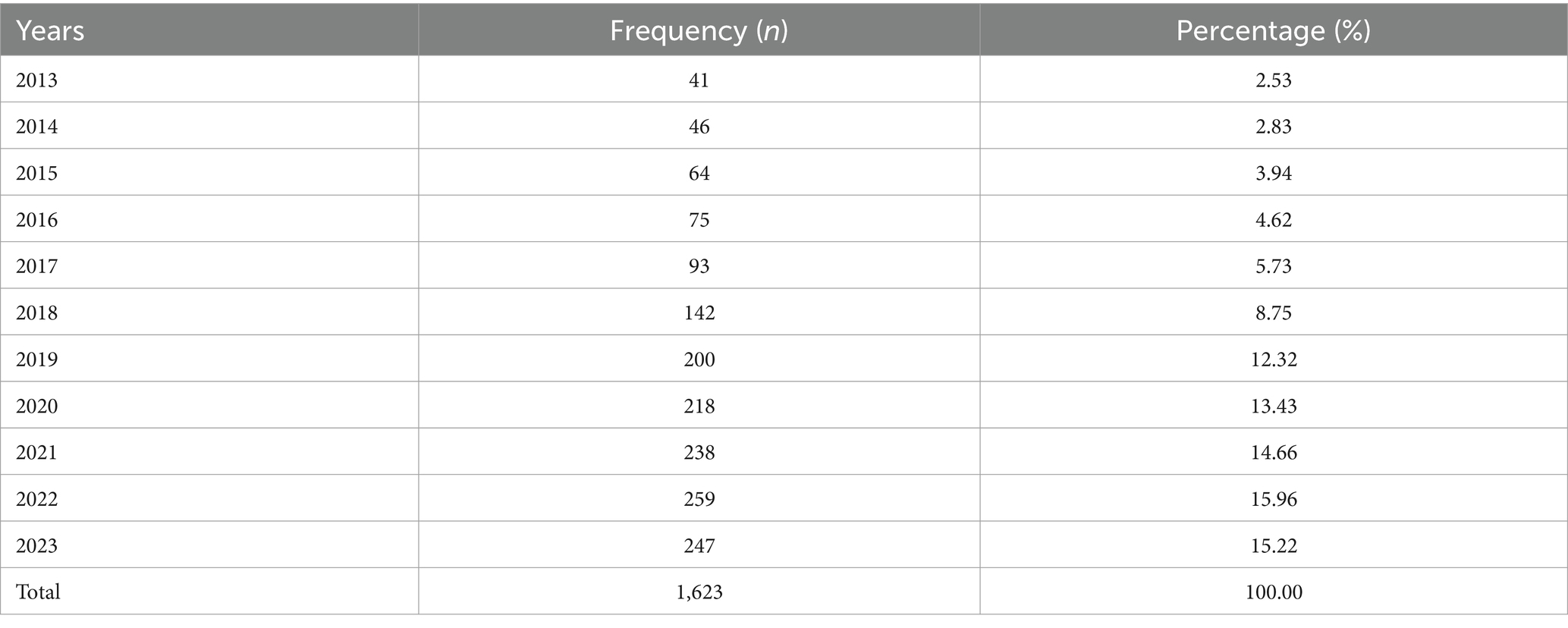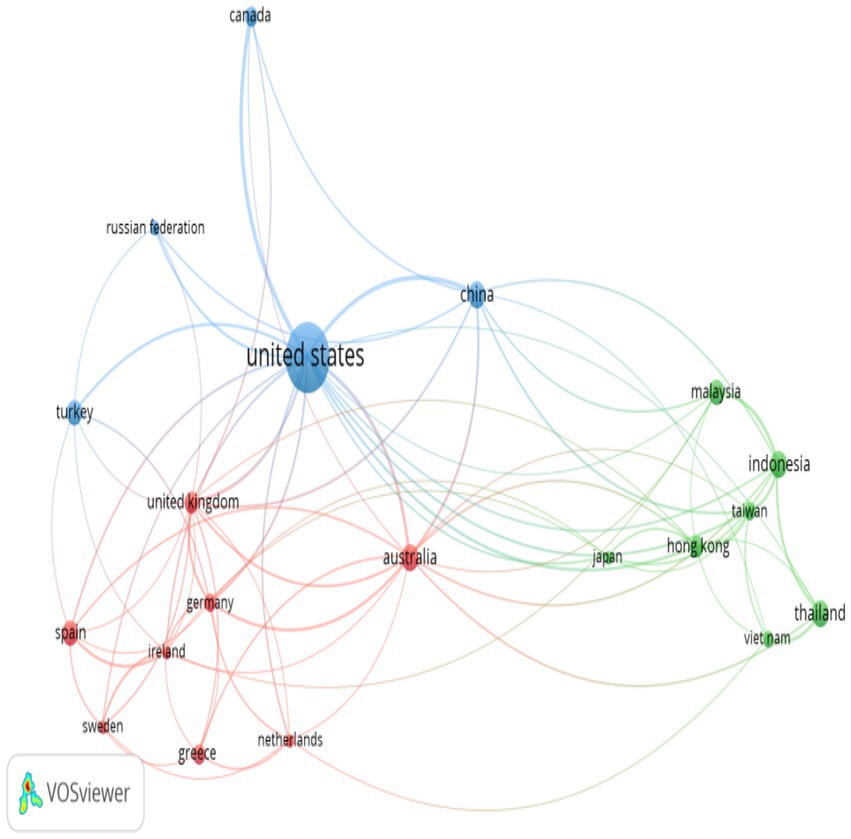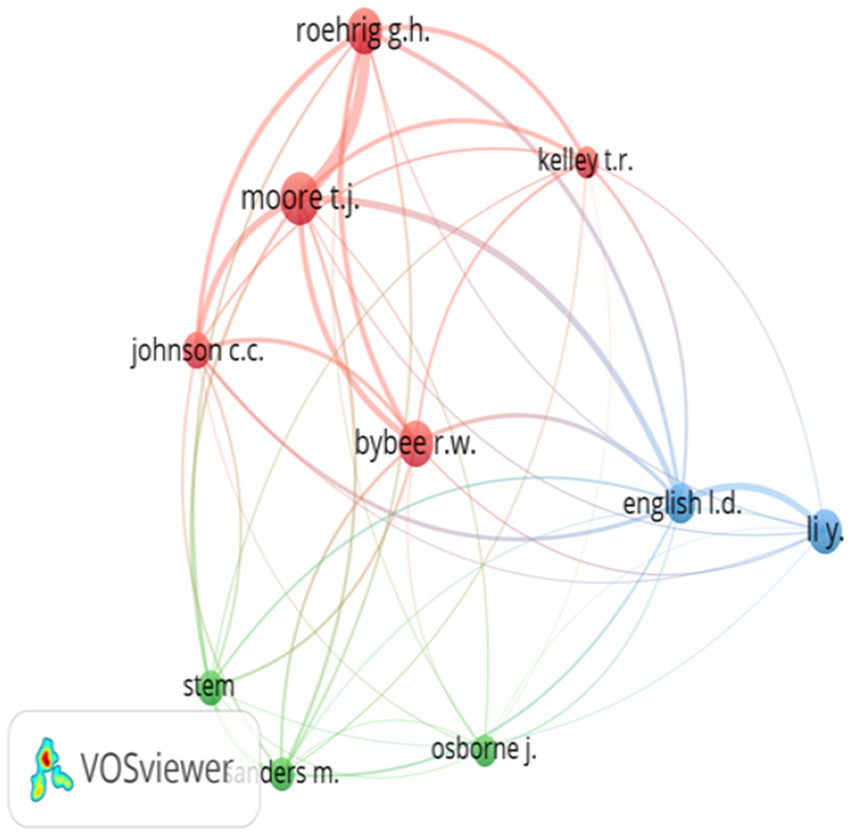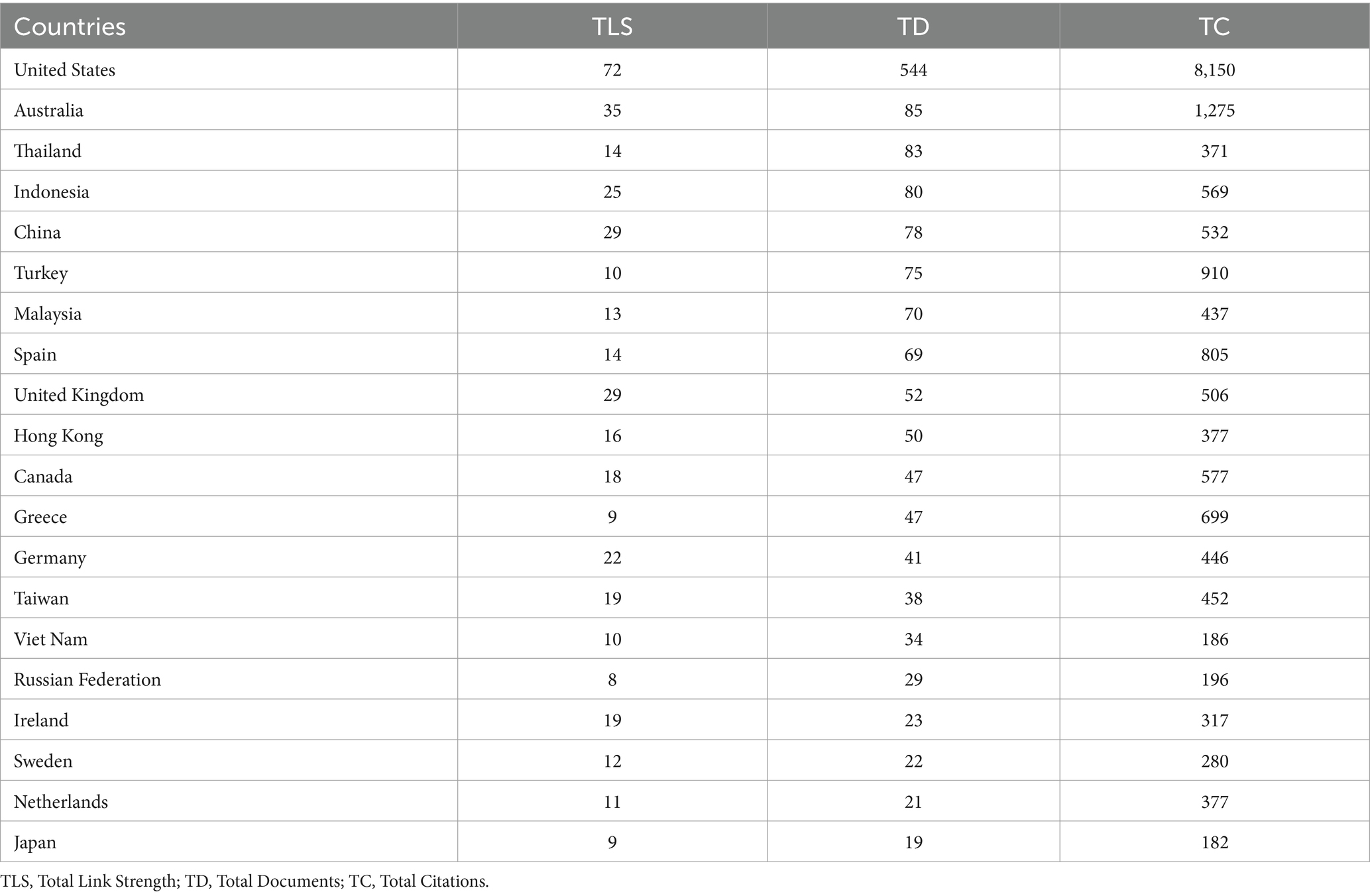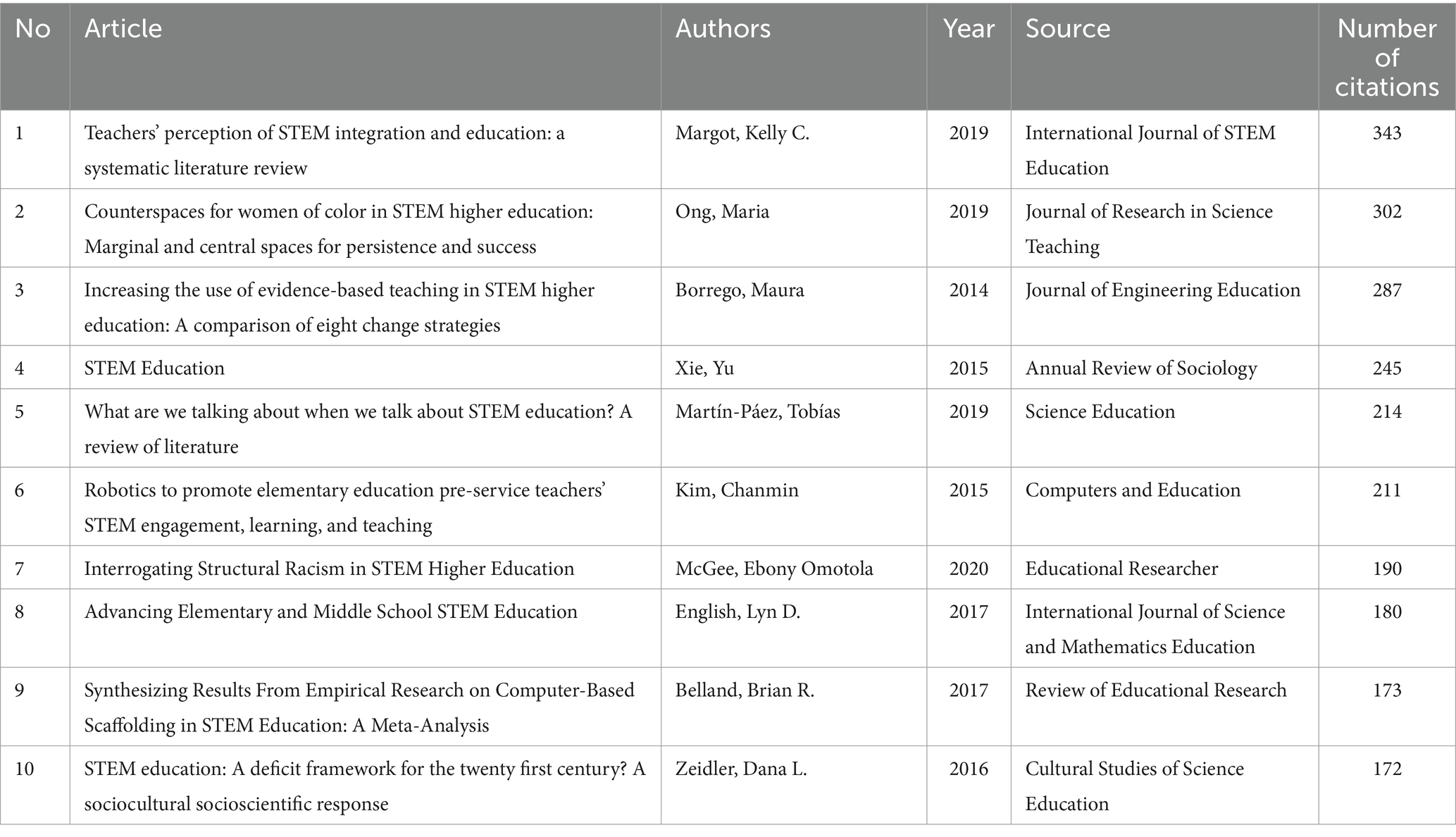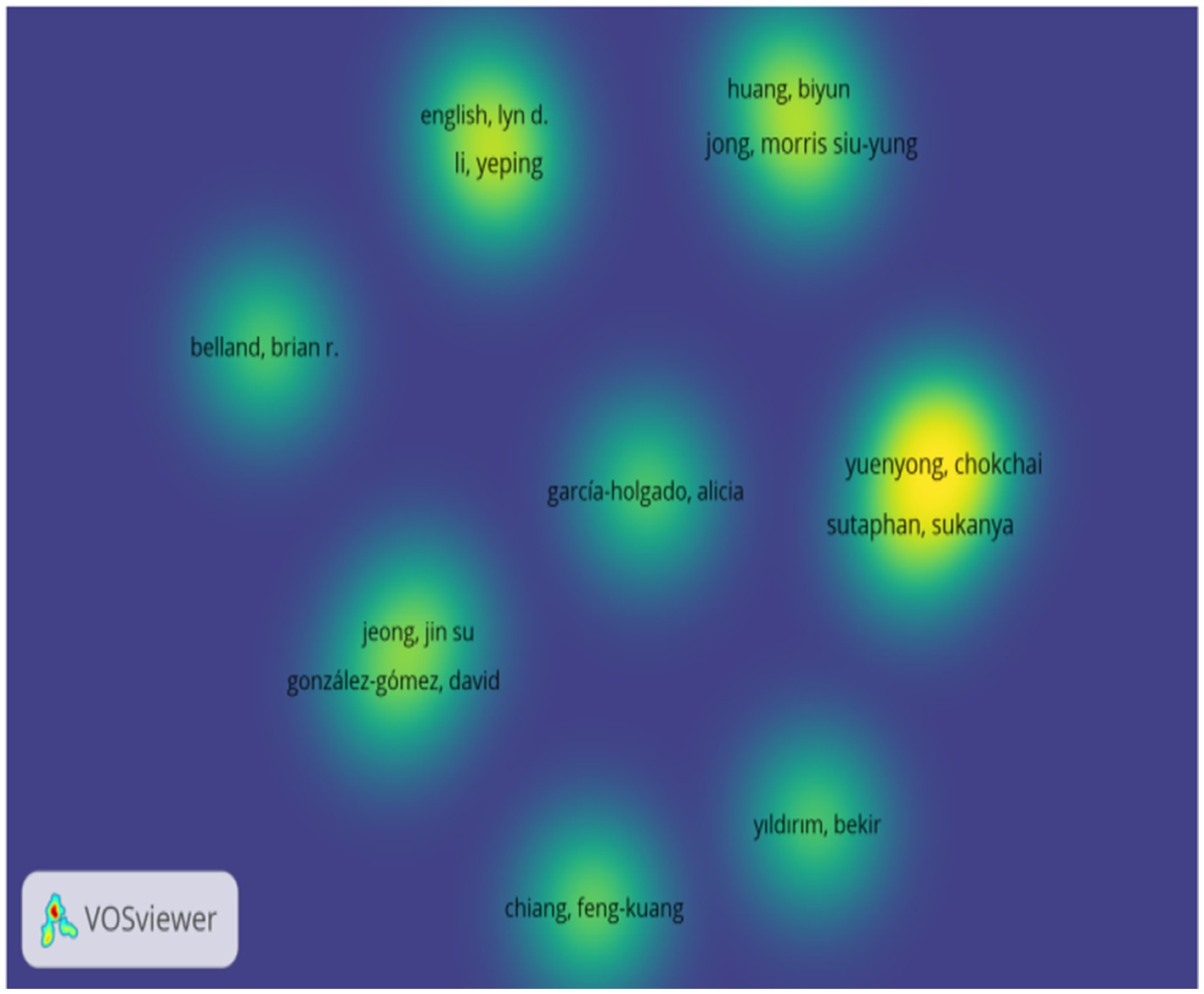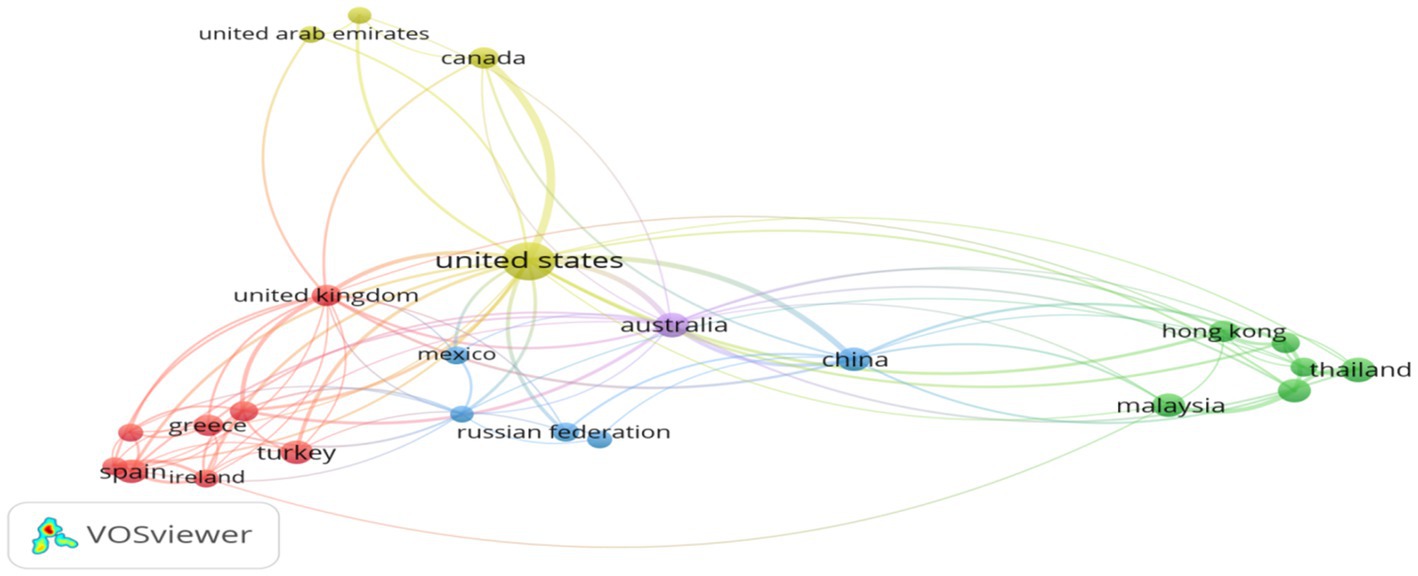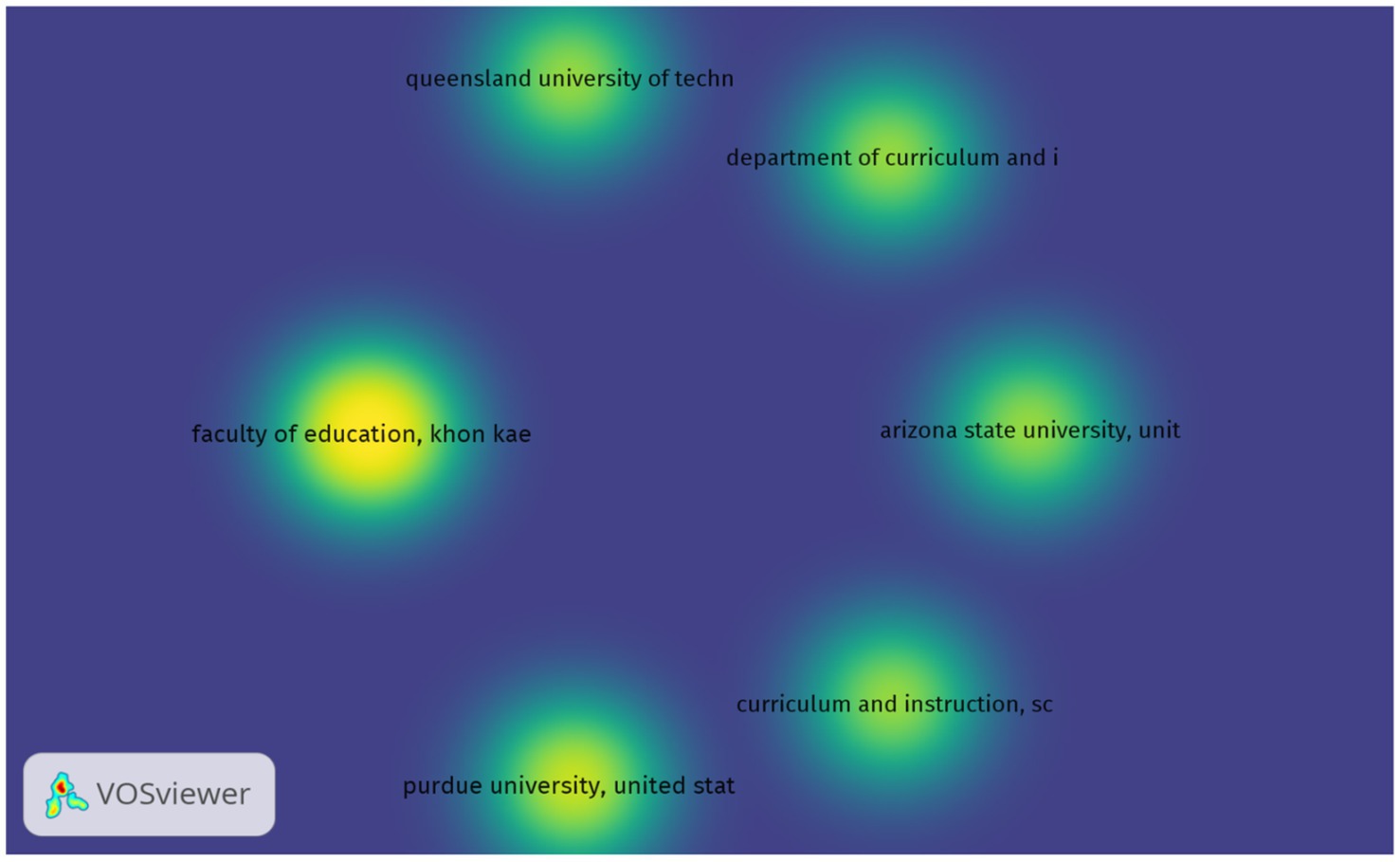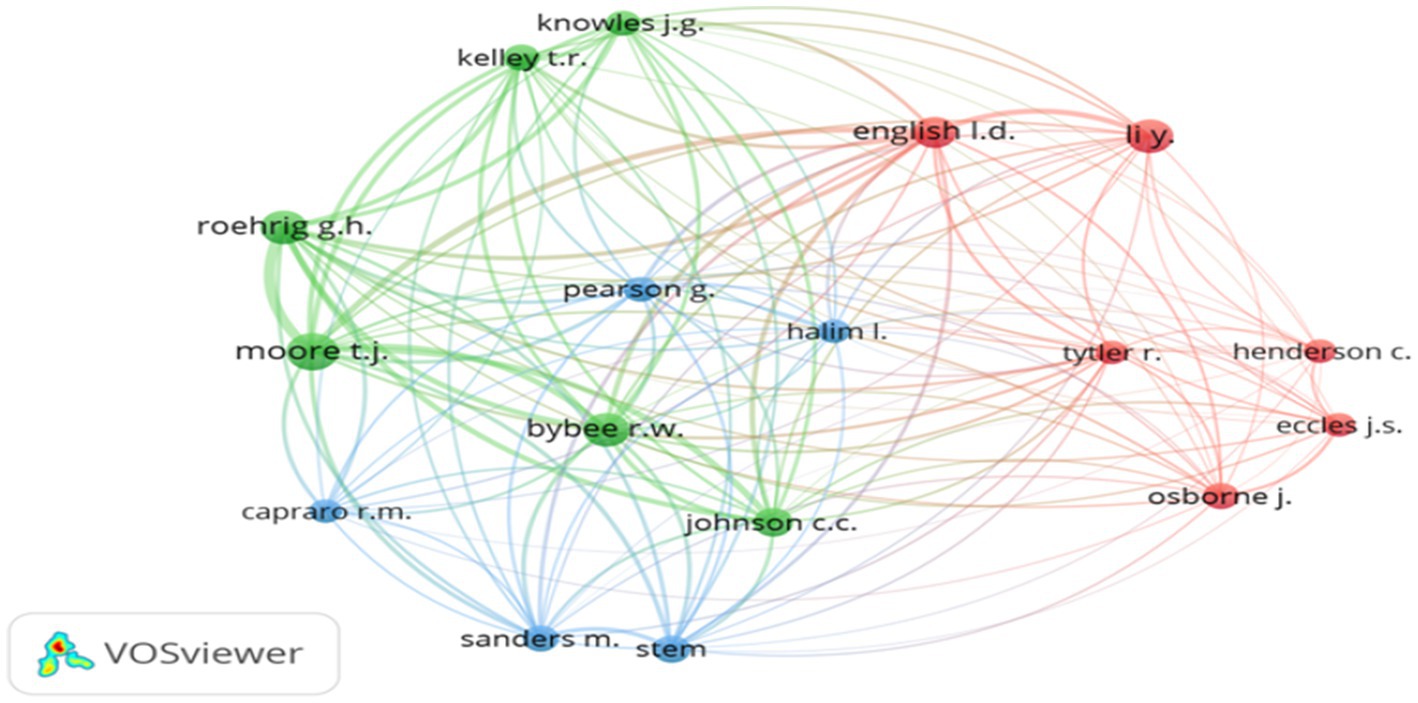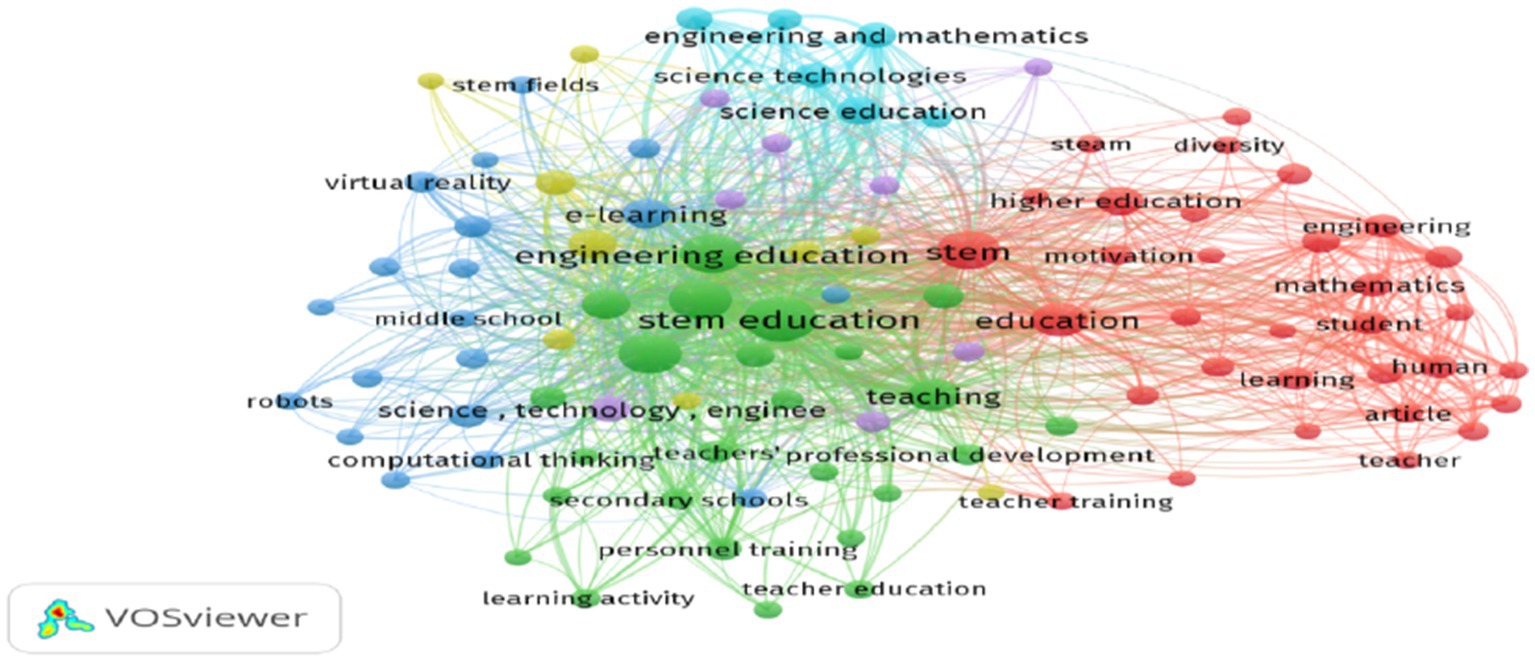- 1Faculty of Education, SIMAD University, Mogadishu, Somalia
- 2Colleges of Education and External Studies, Makerere University, Kampala, Uganda
This study presents a comprehensive bibliometric analysis of scientific research in STEM (Science, Technology, Engineering, and Mathematics) education. One thousand six hundred twenty-three studies on STEM education published between 2013 and 2023 were analyzed using bibliometric methods to uncover trends over the past decade. The analysis commenced by searching the Scopus database Core Collection for “STEM Education” publications, and bibliometric data associated with these studies was collected. The collected publications were then analyzed using VOS-viewer, a bibliometric analysis tool, to examine various bibliographic attributes. The analysis focused on key aspects such as the number of publications per year, publication types, the language of publications, year Citation Analysis, Country Collaborations, Citation Analysis (Journal, Author, Institution and Document), Co-author Analysis (Author, Countries, Institution), Co-citation Analysis (Author), and Co-occurrences Analysis. The analysis findings were visualized using VOS-viewer, a bibliometric analysis tool to depict collaboration patterns and relationships. The analysis recommends future research in STEM education to enhance interdisciplinary collaboration, address the digital divide, and integrate informal learning environments. It also underscores the importance of international collaborations, teacher professional development, and robust assessment frameworks for measuring STEM education effectiveness.
1 Introduction
STEM (science, technology, engineering, and mathematics) education refers to teaching and learning in science, technology, engineering, and mathematics, which usually comprises educational activities across all grade levels, from pre-school to post-doctoral, and in both formal and informal classroom settings (Abdi et al., 2024; Aboudahr et al., 2024; Shrivastava and Mahajan, 2023). STEM education is a learning approach that integrates academic concepts with real-world applications in the fields of science, technology, engineering, and mathematics, using various methods such as problem-solving, inquiry-based learning, and hands-on activities. It involves students using their knowledge and skills to solve practical problems in various contexts, making connections between schools, communities, workplaces, and global institutions. This approach emphasizes learning through practice and is focused on finding practical solutions (Legewie and DiPrete, 2014).
STEM education has become a critical focus of global educational strategies due to its role in preparing students for a technology-driven economy. As the demand for skills in these areas increases, STEM education is recognized as essential for fostering innovation, critical thinking, and problem-solving abilities (Aslam et al., 2022; Mudaly and Chirikure, 2023).
The 21st century has witnessed the concomitant advancement of technology alongside the transformation of human existence. Hence, it is imperative for students to be well equipped to tackle forthcoming obstacles. Scientific inquiry, scientific practices, and engineering practices are necessary to cultivate students’ ability to adapt and address novel contexts and issues, so fostering good citizenship (Li et al., 2022; Thu et al., 2021).
STEM education has been adopted and implemented in numerous countries (Cai et al., 2023). The rapid transformation-taking place in science and technology is influencing the development of individuals who are increasingly capable of generating and applying knowledge effectively in their everyday lives. Studies indicate a rise in STEM-related skills, critical thinking, and entrepreneurial qualities among students (Shahin et al., 2021). This shift aligns with the evolving demands of both individuals and communities, as recognized by the Ministry of Education of Turkey (Baterna et al., 2020; Özkaya, 2019).
In recent years, there has been a growing recognition of the significance of STEM education in numerous countries worldwide, leading to increased attention from policy makers. Many countries engage in extensive discussions on STEM, often citing a shortage of highly qualified labor (Riera et al., 2016). STEM education can begin while pupils are very young, from elementary school to high school (Thu et al., 2021). A study conducted by Legewie and DiPrete (2014) has demonstrated that middle school science classes—and particularly the science instructor—can significantly influence students’ decisions to pursue scientific studies at higher levels of education. Therefore, enhancing and expanding STEM instruction in middle schools is essential for encouraging student interest in science, technology, engineering, and mathematics from an early age.
Understanding the growth and development of STEM education research is crucial for assessing its impact and identifying gaps in its implementation across different educational levels. To systematically explore the evolution and global trends of STEM education, this study conducts a bibliometric analysis using statistical and mathematical techniques to evaluate patterns within academic literature (Pritchard, 1969). The study aims to uncover the overall structure of scientific knowledge and communication in STEM education by analyzing the temporal and geographical distribution of publications, citation rankings of authors, journals, and institutions, and structures in co-author, co-citation, and co-occurrence analysis. Drawing on a global perspective through the Scopus database, the findings offer a comprehensive understanding of the international research landscape, with the goal of guiding future professionals, shaping STEM education practices, and providing insights into emerging trends and key contributors in the field (Cai et al., 2023).
Through the utilization of this methodology, it becomes feasible to evaluate the efficacy of authors, establishments, and nations. The utilization of data mapping enables the quantitative visualization of the structure and dynamics of the areas being investigated. Bibliometric studies facilitate the identification of patterns within a specific sector by quantifying the body of literature (Jamali et al., 2023). In bibliometric investigations, the application of citation analysis allows for the evaluation of the credibility of scientific publications. The distinguishing features of bibliometric analysis set it apart from meta-analysis. The objective of meta-analysis is to identify the existence of a certain effect, evaluate the lack of consistency among scientific articles, investigate the underlying factors contributing to this impact, and analyze the diversity among research studies. Bibliometric analysis and content analysis share similarities in their aim to combine similar data inside a framework of established concepts and topics, and then interpret them in a way that is understandable to readers (Phuong et al., 2023).
Social network analysis is used in bibliometric studies to examine scientific cooperation and co-citation relations (Osman and Abukar Mukhtar, 2023). Social network analysis is an important tool for identifying information networks that are effective in the development of research area. Thanks to the social network analysis, it is possible to visualize the networks of collaboration between authors and institutions and co-citation networks, so that important actors in the research area can be identified (Ali and Tse, 2023).
The most important data sources of bibliometric researches are international scientific citation indexes, particularly Science Citation Index (SCI), Social Science Citation Index (SSCI) and Art & Humanities Citation Index (A&HCI). These indexes can be accessed through Web of Science Core Collection database. Web of Science (WoS) makes a significant contribution to bibliometric studies as a database that contains bibliometric data about the scientific publications scanned in these (Ishmuradova et al., 2023).
The objective of this study is to perform a bibliometric analysis of scientific research published in the field of STEM education. The aim is to determine the overall structure of scientific knowledge and the communication patterns within the field using an unbiased method based on data. Therefore, the progress of research in the domain of STEM education may be ascertained. Another objective of this study is to make a valuable contribution toward the development of a comprehensive plan that will guide future professionals in this subject. For the main purpose of this study, this research is designed to answer the following questions:
1. What is the chronological distribution of the pertinent publications?
2. What is the geographical distribution of the pertinent publications?
3. What are the citation rankings for relevant publications, authors, journals, and institutions?
4. What type of structure arises in relation to co-author analysis?
5. What type of structure arises in relation to co-citation analysis?
6. What type of structure arises in relation to co-occurrences?
The review of bibliometric studies in the literature revealed that there are many domestic and international studies evaluating the articles published in the journals, graduate theses, and papers presented at congresses and symposia (Bornmann and Mutz, 2015; Furkan and Yardımcıoğlu, 2017; Khan et al., 2016; Talan, 2021). On the other hand, there are no STEM education-related bibliometric studies in the domestic literature, although they are extremely rare in the foreign literature.
In their study, Yu et al. (2016) analyzed 385 papers in SSCI (Social Science Citation Index) journals published between 1992 and 2013 that contained the keyword ‘STEM Education.’ They identified a significant increase in STEM education-related studies since 2008. This growth highlights the rising academic interest in STEM education, supporting the need for further investigation into research trends and contributions. Additionally, the study found that most publications originated from the United States (52%), followed by England (9%), the Netherlands (4%), and Australia (4%). The analysis also revealed that the subject areas most often examined in STEM education were Educational Research (51%), Psychology (32%), Engineering (23%), and Medical Science Research (12%). This analysis provides context for the current study’s bibliometric examination and helps to identify gaps and trends in the global landscape of STEM education research.
2 Methodology
This study uses the bibliometric analysis method to investigate papers on the usage of tracing the evolution of STEM education. Bibliometrics is a technique used in many areas today to quantify and analyze scientific publications using mathematical and statistical methods (Pritchard, 1969). Bibliometric analysis is frequently used to evaluate citation patterns and measure the performance and influence of publications within a field. Citation parameters include the most cited study, the most cited author, the most cited journal, the most studied topic, the most collaborated country, bibliometric coupling, authors cited together in a study, and keywords and concepts they frequently employ while discussing a specific subject. The difficulties that come to the fore about the performance of the publications are mainly to compare the situations of individuals, institutions, and countries (Uğuz et al., 2017).
2.1 Data collection
Figure 1 shows the study selection procedure for articles, which involved using the Scopus database and advanced search capabilities. The author team applied advanced search options and operators to ensure the identification of relevant articles, ensuring a comprehensive and rigorous process. This systematic approach enhances the credibility and dependability of the study’s conclusions.
To provide further clarity on the search methodology, we conducted the search using the following query in the article title field of the Scopus database:
TITLE (“STEM AND Education”) AND PUBYEAR >2012 AND PUBYEAR <2024 AND (LIMIT-TO (EXACTKEYWORD, “STEM Education”) OR LIMIT-TO (EXACTKEYWORD, “STEM (science, technology, engineering, mathematics)”)
This query ensured that documents published between 2013 and 2023, containing relevant keywords, were included in the search results. After the initial identification of 1,626 records, we applied the following inclusion/exclusion criteria: Duplicates removed: two records, Documents with no author: one record excluded. After these adjustments, 1,623 records were included in the final bibliometric analysis. This approach ensured that only high-quality, relevant articles were selected for further analysis.
2.2 Data analysis
In this study, both bibliometric and descriptive content analyses were employed to evaluate the data. Content analysis was conducted using the Scopus database’s system to explore themes and trends in STEM education research. For the bibliometric analysis, VOSviewer (Version 1.6.16, Centre for Science and Technology Studies of Leiden University). Expanding the period beyond this would risk including outdated trends, while a narrower range could limit the depth of insights.
To clarify the data collection process, the search was conducted using the following query in the article title field of the Scopus database:
TITLE (“STEM AND Education”) AND PUBYEAR >2012 AND PUBYEAR <2024 AND (LIMIT-TO (EXACTKEYWORD, “STEM Education”) OR LIMIT-TO (EXACTKEYWORD, “STEM (science, technology, engineering, mathematics)”)
This search yielded 1,626 records, from which two duplicate records and one document without an author were removed, resulting in a final dataset of 1,623 records for analysis. This process ensures the credibility and rigor of the study’s conclusions.
3 Results
The following findings have been reached in accordance with the purpose of the research, which aimed to analyze the structure and patterns of scientific knowledge in STEM education through bibliometric analysis. Specifically, this includes identifying publication trends by year and country, highlighting the most influential authors, journals, and institutions, and examining collaborative networks and thematic connections in the literature. The findings are presented in tables and figures to provide a comprehensive overview of the key patterns and trends uncovered in the data.
3.1 Distribution of publications by year, type, and language
3.1.1 Number of publications according to years
An analysis of 1,623 STEM education studies published between 2013 and 2023 revealed that the most research was published in 2022 (n = 259). One potential reason for this peak could be the impact of the COVID-19 pandemic, which led to significant changes in educational practices and a shift toward remote and technology-enhanced learning. These changes may have spurred interest in STEM education research, as educators and policymakers sought innovative solutions for teaching during the pandemic. Additionally, the lockdowns and disruptions to traditional education could have provided more time for researchers to conduct and publish their work, with many papers submitted in 2021 being published in 2022, considering the typical lead-time from submission to publication. According to the findings in Table 1 and Figure 1, despite the fact that there were 151 publications in STEM education from 2013 to 2015, academic interest in this topic has significantly increased since 2019. The publication rate over the last 5 years, from 2019 to 2023, represents 71.59% of total publications.
3.1.2 Types of publication
Table 2 shows that the publications were published in five different formats based on their genre (articles, book chapters, conference papers, editorials, reviews). Because some of the research were evaluated using scope Scopus across multiple publication types, the ratios were determined using the total number of 1,623 publications. From 2013 to 2023, 719 articles and 83 book chapters were published, followed by 752 conference papers, 12 editorials, and 51 reviews.
Table 3 shows that the studies were published in seven different languages, the majority of which were in English (n = 1,592). The rationale for this result is that scientific communication takes place in English all over the world. Following English, there were 23 publications in Spanish, 3 in Russian, 2 in Portuguese, 1 in German, 1 in Turkish, and 1 in Lithuanian (Figure 2).
3.2 Analysis of country collaborations and common citation networks in journals, authors, institutions, and documents
3.2.1 Country collaborations
An examination of social networks was carried out in order to ascertain the collaborative endeavors of the researchers in accordance with their respective countries. The names of the countries were ranked according to the degree of collectivism, and the results are displayed in Figure 3.
According to the findings in Table 4, the United States appears to be the most collaborative with other countries in terms of total link strength, total documents, and total citations (TLS = 72, TD = 544, TC = 8,150). At the same time, the United States is the country with the highest centrality score, underscoring its pivotal position in fostering global scientific partnerships. Consequently, it is evident that the United States significantly influences the establishment and sustenance of international scientific networks. Moreover, the data suggests that Australia is shaping the trajectory of future research endeavors within the STEM education domain. As a result, it can be concluded that the United States plays an important role in creating and maintaining international scientific collaborations. Furthermore, it may be argued that Australia is guiding future research in the STEM education field (Table 5).
3.2.2 Journal’s common citation network
The journals with the most publications on the subject in Scopus were analyzed first. Table 6 presents the pertinent data. When the journal-based distribution of publications is studied, it is discovered that the most published journals are “Journal of Physics: Conference Series” (n = 116) and “ASEE Annual Conference and Exposition, Conference Proceedings” (n = 83). When the number of citations per article is checked, we discovered that the publications “International Journal of STEM Education,” “Journal of Physics: Conference Series,” and “Sustainability (Switzerland)” are the most cited.
3.2.3 Author’s common citation network
The study also looked at the authors of works on the issue using Scopus citation data. Table 6 shows the number of papers and citations by the most productive and prominent authors on the subject. The top 12 writers with at least five papers in relevant references are ranked by citation count. When the table is studied, it is clear that the authors “English, Lyn D.” and “Belland, Brian R.” excel in terms of productivity and influence.
3.2.4 Institution common citation
The study looked at the article and citation rankings of the authors’ respective institutions. Table 7 contains the data connected to this. “Queensland University of Technology, Brisbane” emerges as the most productive institution in terms of citations. In contrast, “The Chinese University of Hong Kong, Hong Kong” is the most productive university in terms of publications and ranks second in terms of citations. The top-ranked institutions are located in Australia.
3.2.5 Documents’ common citation
Within the scope of the study, the data gathered by reviewing the most cited articles on the issue are listed below (see Table 8). Table 8 provides information about the most frequently cited papers in Scopus, including their subject, authors, and citation numbers. According to these findings, the most frequently cited publication, with 343 citations, was “Margot, Kelly C. (2019).” This is followed by the articles “Ong, Maria. (2019)” and “Borrego, Maura. (2014).”
3.3 Co-author analysis (author, countries, institution)
The data obtained by examining cooperation between the authors of the publications in Scopus are given below (see Figure 4). When the co-author analysis of the studies on the subject is examined, it is seen that the authors who publish together generally have publications separately and in small groups. In addition, it is seen that there are authors who publish individually. Examples of outstanding author collaborations are “english, lyn d.,” “belland, brian r.,” “li, yeping.” and “yuenyong, chokchai.”
The analysis of co-authors for cross-country cooperation is presented in Figure 5. This figure shows that the closer the two countries are, the stronger and wider the connections of these countries. When the countries of the co-authors are examined, it is seen that United States worked with 20 countries and Australia with 16 countries. United Kingdom followed the list (16 links), China (10 links), Netherlands (10 links) and others.
In order to comment on the institutions that the co-authors belong to, a heat map was utilized. Figure 6 depicts the co-author analysis for the purpose of comparing the cooperation between different institutions. When the institutions of the co-authors are studied, it is observed that the network structure is quite complex, and there is no major relationship structure. This is something that can be seen in Figure 6, which can be seen here. When the map is looked at in a general manner, it becomes apparent that the following institutions “Queensland University of Technology, Brisbane, Australia,” “Department of Curriculum and Instruction, the Chinese University of Hong Kong, Hong Kong,” “Arizona State University, United States,” “Purdue University, United States,” “Faculty of Education, Khon Kaen University, Thailand,” “Thai Nguyen University of Education, Thai Nguyen, Viet Nam” and Higher Education “Curriculum and Instruction, School of Education, University of Phayao, Phayao, 56,000, Thailand” are the most frequently encountered.
3.4 Co-citation analysis (author)
The network structure of the co-citation analysis of the publications on the subject is given in Figure 7. Each round figure in Figure 7 indicates an author. Large circles indicate the predominance of cited publications. If there is a line between two author names, it indicates that these two authors work together. When the common citation network is examined, three different colored clusters are seen. Authors who receive many citations together are gathered in the same cluster. Publications in the center show that they are often cited from different fields and have more detailed connections with many clusters. Examining Figure 7 in its entirety, the red, green, and blue clusters are large and more prominent than the others.
3.5 Co-occurrences analysis
On display in Figure 8 is the network structure that represents the relationships that exist between keywords. A subject that is addressed more frequently is shown by a larger circle size, while the yellow spots show the subjects that are now being discussed. It is possible to observe that the terms “STEM education,” “Engineering Education,” “Students,” “STEM,” and “STEM (Science, Technology, Engineering, and Mathematics)” are situated in the middle of the map, as shown in Figure 8. These words are among the concepts that have been investigated in conjunction with other clusters, and they have been determined to be the keywords that are utilized the most frequently. It is important to pay attention to the fact that the subjects that are now being discussed include “STEM education,” “Engineering Education,” and “STEM.”
4 Discussion and conclusion
The primary objective of this study was to conduct a bibliometric analysis of STEM education research, examining how scientific knowledge and communication structures have developed between 2013 and 2023. Using the Scopus Core Collection, 1,623 studies were analyzed through descriptive and bibliometric methods, with visualization provided by VOSviewer. These analyses allowed us to assess publication trends, country collaborations, citation patterns, and co-occurrence networks. The aim was to provide insights into the structure and dynamics of STEM education research, which can inform future research directions and policy decisions.
The results show that STEM education research has seen a notable increase in publications, particularly after 2019. The significant growth (71.59% of total publications between 2019 and 2023) aligns with broader global initiatives aimed at integrating STEM into educational frameworks. This suggests an increasing recognition of STEM education’s critical role in preparing students for rapidly advancing technological economies. The surge in 2022, in particular, may have been influenced by post-pandemic shifts in education, with remote learning driving interest in digital and technology-enhanced learning environments.
Furthermore, the geographical distribution of publications reveals the dominance of English-language studies (98.09%), underscoring the influence of English-speaking countries in shaping STEM education research. The United States and Australia were the most prominent countries in terms of both volume of publications and collaborations, indicating their leading role in STEM education globally. This dominance highlights the importance of considering regional differences in STEM education policies and implementation, particularly as these countries contribute significantly to international research networks.
Collaborative networks were most active between the United States and 20 other countries, followed by Australia with 16 collaborative links. These strong international partnerships suggest that leading nations are playing a pivotal role in advancing the global STEM education agenda. The citation rankings of journals, institutions, and authors further demonstrate how certain regions, particularly the United States and Australia, have become central hubs of research output and influence.
However, it is worth noting the emergence of countries like Thailand and China, which are gaining prominence in STEM research. For instance, Khon Kaen University in Thailand has produced a substantial volume of STEM education research, indicating a growing interest in the field in Southeast Asia. This geographical shift may reflect broader efforts to address regional challenges in education, economic development, and workforce demands.
The co-author analysis uncovered the collaborative nature of STEM education research, with prominent authors such as Lyn D. English and Brian R. Belland frequently working together on influential studies. Interestingly, these authors also publish independently or in smaller groups, contributing to diverse areas of STEM education. This suggests that influential researchers in the field are not only central to collaboration networks but also capable of driving innovation in various subfields of STEM education.
Co-citation analysis showed that specific clusters of authors (e.g., those focusing on technology-enhanced learning) are consistently cited together, reinforcing the thematic focus on digital tools and remote learning. These clusters are indicative of research communities that are driving the current understanding and future directions of STEM education, with a strong emphasis on emerging technologies and interdisciplinary approaches.
The co-occurrence analysis revealed frequently used keywords such as “STEM education,” “Engineering Education,” and “Students,” which align with the focus of recent studies on hands-on learning and digital integration. Additionally, emerging themes such as “augmented reality,” “simulation,” and “virtual learning environments” reflect the growing interest in applying cutting-edge technologies in STEM classrooms. These keywords suggest that future research will likely continue to explore the intersection of technology and education, particularly in terms of how digital tools can enhance student engagement and learning outcomes.
4.1 Limitations and future directions
While this study offers valuable insights into the development of STEM education research, it is not without limitations. The reliance on the Scopus database may have excluded relevant studies indexed in other databases, and the focus on English-language publications limits the understanding of research produced in non-English-speaking regions. Future research should consider incorporating data from a broader range of sources and languages to capture a more comprehensive view of global STEM education research.
Moreover, while bibliometric analysis provides a robust method for evaluating research output and influence, it does not capture the full qualitative impact of these studies. For instance, citation counts reflect influence but may not fully represent the practical application of research findings in classroom settings or policy development. Future studies could benefit from combining bibliometric data with case studies or surveys that assess the real-world impact of STEM education research on educational practices and student outcomes.
5 Conclusion
The bibliometric analysis conducted in this study provides a comprehensive overview of the scientific research landscape in the STEM education topic area. The findings demonstrate the growing academic interest, the prominent publication channels, the influential authors and institutions, and the collaborative patterns within the STEM education research community.
The insights gained from this study can inform various stakeholders, including researchers, educators, policymakers, and funding agencies, about the current state of STEM education research. This information is valuable in identifying research trends, such as the growing emphasis on technology-enhanced learning and interdisciplinary approaches within STEM education. It also highlights emerging topics like the integration of artificial intelligence in STEM teaching, gender disparities in STEM fields, and the development of problem-solving skills through hands-on learning. These insights provide a basis for potential future investigations and contribute to the advancement of STEM education practices and the promotion of interdisciplinary learning.
Furthermore, the bibliometric approach employed in this study showcases the utility of data-driven analysis in understanding the structure and dynamics of a scientific field. This methodology can be replicated and applied to other research domains, fostering a better understanding of the evolution and impact of scholarly activities across various disciplines.
Data availability statement
The data used in this study are publicly available and were obtained from the Scopus database. Researchers interested in accessing and using the data can retrieve it from the Scopus database, subject to the terms and conditions of the database.
Ethics statement
This study adheres to ethical guidelines and protocols for conducting research. The authors obtained permission to use the Scopus database for data collection and analysis. All data used in this study are publicly available and were retrieved in accordance with the terms and conditions of the database. No personal or sensitive information was involved in this research. The study did not involve human subjects or animal experimentation.
Author contributions
AO: Writing – original draft, Writing – review & editing, Conceptualization, Data curation, Formal analysis, Funding acquisition, Investigation, Methodology, Project administration, Resources, Software, Supervision, Validation, Visualization. AA: Conceptualization, Data curation, Formal analysis, Funding acquisition, Investigation, Methodology, Project administration, Resources, Software, Supervision, Validation, Visualization, Writing – original draft, Writing – review & editing. AM: Conceptualization, Data curation, Formal analysis, Funding acquisition, Investigation, Methodology, Project administration, Resources, Software, Supervision, Validation, Visualization, Writing – original draft, Writing – review & editing. CA: Conceptualization, Data curation, Formal analysis, Funding acquisition, Investigation, Methodology, Project administration, Resources, Software, Supervision, Validation, Visualization, Writing – original draft, Writing – review & editing. MO: Conceptualization, Data curation, Formal analysis, Funding acquisition, Investigation, Methodology, Project administration, Resources, Software, Supervision, Validation, Visualization, Writing – original draft, Writing – review & editing.
Funding
The author(s) declare that financial support was received for the research, authorship, and/or publication of this article. The authors thank SIMAD University for funding this study under the Research Grant Scheme (Revitalizing stem education in post-conflict Somalia: the role of higher education in developing hands-on and experiential learning opportunities) with Grant No: SU-STEM-2023-005. The authors also thank all the respondents of this research.
Acknowledgments
We would like to express our sincere gratitude to all individuals and organizations who contributed to the completion of this study. We appreciate the support and guidance provided by our colleagues and advisors throughout the research process. Additionally, we extend our thanks to the participants who generously shared their expertise and insights. This study would not have been possible without their valuable contributions.
Conflict of interest
The authors declare that the research was conducted in the absence of any commercial or financial relationships that could be construed as a potential conflict of interest.
Publisher’s note
All claims expressed in this article are solely those of the authors and do not necessarily represent those of their affiliated organizations, or those of the publisher, the editors and the reviewers. Any product that may be evaluated in this article, or claim that may be made by its manufacturer, is not guaranteed or endorsed by the publisher.
References
Abdi, A. I., Omar, A. M., Mahdi, A. O., Osman, M. A., and Asiimwe, C. (2024). Assessing higher education students’ perception towards their engagement in pedagogical STEM approach. Int. J. Adv. Appl. Sci. 11, 171–179. doi: 10.21833/ijaas.2024.02.018
Aboudahr, S., Aslam, S., Hua, L. U., Misron, A., Raime, S., and Wah, Y. B. (2024). Mapping the global landscape of STEM education: a bibliometric analysis using Scopus database. Int. J. Eval. Res. Educ. 13, 4225–4236. doi: 10.11591/ijere.v13i6.28687
Ali, M., and Tse, A. W. C. (2023). Research trends and issues of engineering design process for STEM education in K-12: a bibliometric analysis. Int. J. Educ. Math. Sci. Technol. 11, 695–727. doi: 10.46328/ijemst.2794
Aslam, S., Saleem, A., Kennedy, T. J., Kumar, T., Parveen, K., Akram, H., et al. (2022). Identifying the research and trends in STEM education in Pakistan: a systematic literature review. SAGE Open 12:21582440221118545. doi: 10.1177/21582440221118545
Baterna, H. B., Mina, T. D. G., and Rogayan, D. V. (2020). Digital literacy of STEM senior high school students: basis for enhancement program. Int. J. Technol. Educ. 3:105. doi: 10.46328/ijte.v3i2.28
Bornmann, L., and Mutz, R. (2015). Growth rates of modern science: a bibliometric analysis based on the number of publications and cited references. J. Assoc. Inf. Sci. Technol. 66, 2215–2222. doi: 10.1002/asi.23329
Cai, Z., Zhu, J., and Tian, S. (2023). Research progress of STEM education based on visual bibliometric analysis. SAGE Open 13, 1–13. doi: 10.1177/21582440231200157
Furkan, B., and Yardımcıoğlu, F. (2017). Maliye Dergisi’nin Bibliyometrik Analizi: 2007-2016 Dönemi. Maliye 172, 133–151.
Ishmuradova, A. M., Svintsova, M. N., Kondakchian, N. A., Zaitseva, N. A., Sokolova, N. L., and Khairullina, E. R. (2023). A bibliometric overview of science communication research in STEM education. Online J. Commun. Media Technol. 13:e202341. doi: 10.30935/ojcmt/13415
Jamali, S. M., Ale Ebrahim, N., and Jamali, F. (2023). The role of STEM education in improving the quality of education: a bibliometric study. Int. J. Technol. Des. Educ. 33, 819–840. doi: 10.1007/s10798-022-09762-1
Khan, M. S., Ullah, W., Riaz, I. B., Bhulani, N., Manning, W. J., Tridandapani, S., et al. (2016). Top 100 cited articles in cardiovascular magnetic resonance: a bibliometric analysis. J. Cardiovasc. Magn. Reson. 18:87. doi: 10.1186/s12968-016-0303-9
Legewie, J., and DiPrete, T. A. (2014). The high school environment and the gender gap in science and engineering. Sociol. Educ. 87, 259–280. doi: 10.1177/0038040714547770
Li, Y., Xiao, Y., Wang, K., Zhang, N., Pang, Y., Wang, R., et al. (2022). A systematic review of high impact empirical studies in STEM education. Int. J. STEM Educ. 9, 1–18. doi: 10.1186/s40594-022-00389-1
Mudaly, R., and Chirikure, T. (2023). STEM education in the global north and global south: competition, conformity, and convenient collaborations. Front. Educ. 8, 1–13. doi: 10.3389/feduc.2023.1144399
Osman, M. A., and Abukar Mukhtar, O. (2023). The factors attributed to students’ low performance in secondary leaving examination: the case of secondary schools in Benadir region of Somalia. J. Educ. Teach. Train. 14, 326–337. doi: 10.47750/jett.2023.14.02.031
Özkaya, A. (2019). STEM Eğitimi Alanında Yapılan Yayınların Bibliyometrik Analizi. Bartın Üniversitesi Eğitim Fakültesi Dergisi 8, 590–628. doi: 10.14686/buefad.450825
Phuong, N. L., Hien, L. T. T., Linh, N. Q., Thao, T. T. P., Pham, H. H. T., Giang, N. T., et al. (2023). Implementation of STEM education: a bibliometrics analysis from case study research in Scopus database. Eurasia J. Math. Sci. Technol. Educ. 19:em2278. doi: 10.29333/ejmste/13216
Riera, B., Emprin, F., Annebicque, D., Colas, M., and Vigário, B. (2016). HOME I/O: a virtual house for control and STEM education from middle schools to universities. IFAC-PapersOnLine 49, 168–173. doi: 10.1016/j.ifacol.2016.07.172
Shahin, M., Ilic, O., Gonsalvez, C., and Whittle, J. (2021). The impact of a STEM-based entrepreneurship program on the entrepreneurial intention of secondary school female students. Int. Entrep. Manag. J. 17, 1867–1898. doi: 10.1007/s11365-020-00713-7
Shrivastava, R., and Mahajan, P. (2023). Altmetrics and their relationship with citation counts: a case of journal articles in physics. Glob. Knowl. Mem. Commun. 72, 391–407. doi: 10.1108/GKMC-07-2021-0122
Talan, T. (2021). Augmented reality in STEM education: bibliometric analysis. Int. J. Technol. Educ. 4, 605–623. doi: 10.46328/ijte.136
Thu, H. L. T., Tran, T., Phuong, T. T. T., Tuyet, T. L. T., Le Huy, H., and Thi, T. V. (2021). Two decades of stem education research in middle school: a bibliometrics analysis in Scopus database (2000–2020). Educ. Sci. 11:353. doi: 10.3390/educsci11070353
Uğuz, S., Aksoy, B., and Oral, O. (2017). The analysis of conceptual development of stem education by bibliometry. J. Educ. Instr. Stud. World 7, 118–128.
Keywords: STEM, education, bibliometric analysis, collaboration patterns, interdisciplinary collaboration
Citation: Abdi AI, Omar AM, Mahdi AO, Asiimwe C and Osman MA (2024) Tracing the evolution of STEM education: a bibliometric analysis. Front. Educ. 9:1457938. doi: 10.3389/feduc.2024.1457938
Edited by:
Zahid Pranjol, University of Sussex, United KingdomReviewed by:
Barbara Jones, The University of Manchester, United KingdomSarfraz Aslam, UNITAR International University, Malaysia
James Williams, University of Sussex, United Kingdom
Copyright © 2024 Abdi, Omar, Mahdi, Asiimwe and Osman. This is an open-access article distributed under the terms of the Creative Commons Attribution License (CC BY). The use, distribution or reproduction in other forums is permitted, provided the original author(s) and the copyright owner(s) are credited and that the original publication in this journal is cited, in accordance with accepted academic practice. No use, distribution or reproduction is permitted which does not comply with these terms.
*Correspondence: Abdirahman Ibrahim Abdi, YWJkaXJhaG1hbmlicmFoaW1Ac2ltYWQuZWR1LnNv
 Abdirahman Ibrahim Abdi
Abdirahman Ibrahim Abdi Abukar Mukhtar Omar
Abukar Mukhtar Omar Abdikarim Osman Mahdi
Abdikarim Osman Mahdi Constance Asiimwe
Constance Asiimwe Mohamed Ali Osman
Mohamed Ali Osman